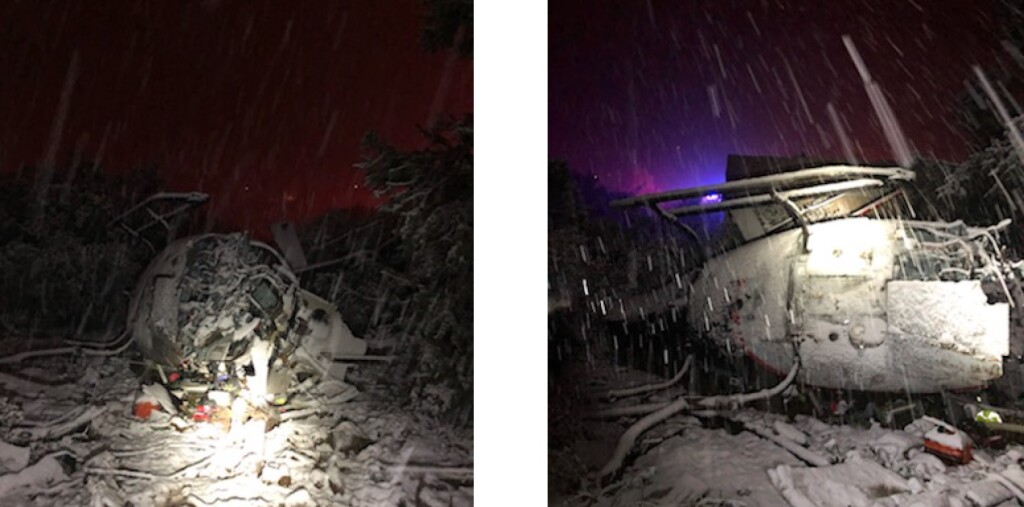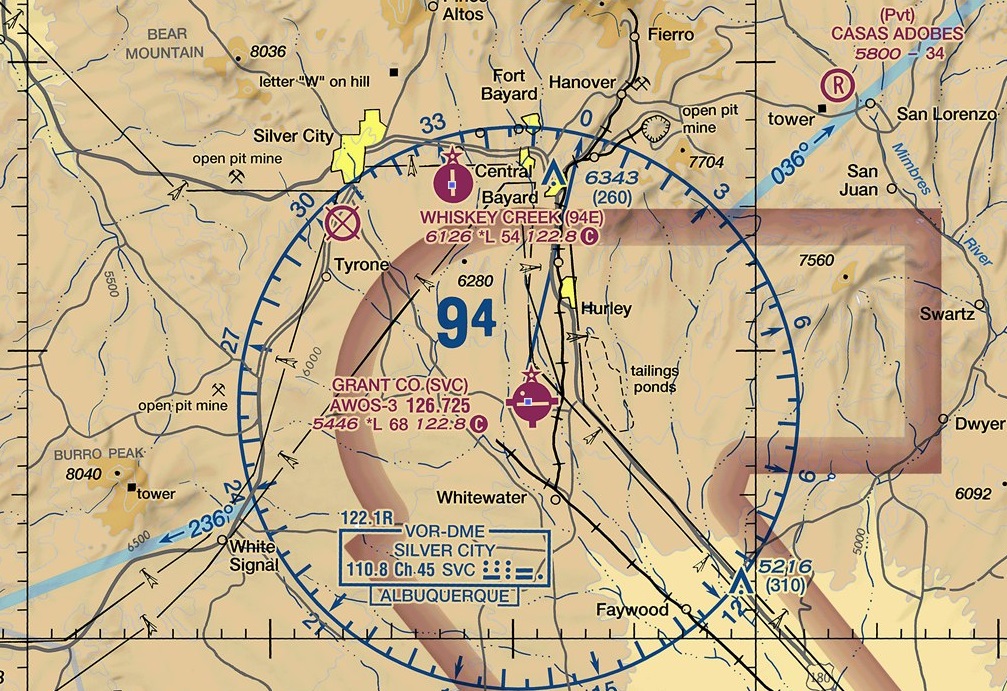Air Methods AS350B3 Night CFIT in Snow (N530H)
On 26 October 2020 Air Methods Corp (AMC) helicopter air ambulance Airbus Helicopters AS350B3 N530H was destroyed when it suffered a Controlled Flight into Terrain (CFIT) 200 m from Whiskey Creek Airport, near Silver City, New Mexico. The aircraft came to rest just 8 m from a house. The pilot, the sole occupant, miraculously suffered only minor injuries. The US National Transportation Safety Board (NTSB) issued their safety investigation report, issued 20 August 2021.

Wreckage of Air Methods Airbus AS350B3 N530H After Night CFIT in Marginal and Deteriorating Weather (Credit: Local Police via NTSB)
The Accident Flight
A storm was approaching, and the intent was to relocate the aircraft from the AMC base at Gila Regional Medical Center (6097 ft AMSL) to the near-by Whiskey Creek Airport (6126 ft AMSL) where AMC had a rented hangar.
The accident flight departed at 23:34 local time. The pilot, who had flown 4200 hours, 1956 on type, stated that night Marginal Visual Flight Rules (MVFR) conditions prevailed (which implies a ceiling between 1,000-3,000 feet and/or 3 to 5 miles visibility). The pilot described how precipitation turned from rain to snow when approaching the airport. The flight followed Highway 180 and turned south towards the airport. On the turn to finals, there was an increase in precipitation, and a reduction in visibility.
The aircraft impacted terrain in a level, or slightly nose-low attitude approximately 200 m NW of the airport, just 3 minutes after take-off. The Emergency Locator Transmitter (ELT) did not activate, a common failure.
The nearest weather data was from Grant County Airport (5446 ft AMSL), 8 nm south of Whiskey Creek. Visibility was 7 miles and ceiling 1300 ft AGL (i.e. c 6750 ft AMSL) at the time of the accident.
The NTSB Probable Cause
The NTSB determined the probable cause to be:
The pilot’s failure to maintain sufficient altitude above terrain while operating in reduced visibility due to snow showers.
Strictly, this is simply a statement of the circumstances of the accident.
Operator’s Recommendation to Repeat an Occurrence
In the accident report form, AMC recommend:
Avoid VFR flight in conditions below VFR weather minimums. Avoid VFR night flight in areas of no illumination or surface reference in poor visibility. Maintain an instrument cross-check when operating in areas of low illumination or low visibility. When encountering areas of deteriorating weather pilots should divert, abort, land or execute the IIMC recovery procedure in accordance with company guidance.
But What About Flight Data Monitoring?
There is no mention of any examination of flight data. The FAA changed Part 135 in 2017 so that helicopter air ambulance operators had to comply with a new Flight Data Monitoring (FDM) System requirement, FAR 135.607:
After April 23, 2018, no person may operate a helicopter in air ambulance operations unless it is equipped with an approved flight data monitoring system capable of recording flight performance data.
FAA AC 135-14B Helicopter Air Ambulance (HAA) Operations explains that:
The FDMS should record digital or analog raw data, images, cockpit voice or ambient audio recordings or any combinations thereof which ideally yield at least the following flight information: • Location; • Altitude; • Heading; • Speeds (airspeed and groundspeed); • Pitch, yaw, and roll attitudes and rate of change; • Engine parameters; • Main rotor RPM; • Ambient acoustic data; • Radio ambient audio; and • Any other parameter the operator deems necessary (e.g., high definition video recording looking forward including instrument panel and forward cockpit windshield view, intercommunications system (intercom) between pilot and medical crew, communications with air traffic control (ATC), OCS, base operations, first responders at scene, hospital, etc.)
So while this sector was classified as a Part 91 positioning flight, it was required as air ambulance to have a suitable FDM System installed, and it would be very unusual to turn the system off for a positioning flight.
Safety Resources
The European Safety Promotion Network Rotorcraft (ESPN-R) has a helicopter safety discussion group on LinkedIn. Read the ESPN-R (formerly EHEST) HE4 leaflet of Decision Making or watch their DVE video:
You may also find these Aerossurance articles of interest:
- NTSB on LA A109S Rooftop Hospital Helipad Landing Accident
- Air Ambulance B407 Hospital Helipad Deck Edge Tail Strike During Shallow Approach
- Air Ambulance Helicopter Fell From Kathmandu Hospital Helipad (Video)
- US Air Ambulance Near Miss with Zip Wire and High ROD Impact at High Density Altitude
- Hazardous Hangar Hovertaxy
- Hanging on the Telephone… HEMS Wirestrike
- Air Ambulance Helicopter Downed by Fencing FOD
- Ambulance / Air Ambulance Collision
- Beware Last Minute Changes in Plan
- Grand Canyon Air Tour Tragic Tailwind Landing Accident
- A Short Flight to Disaster: A109 Mountain CFIT in Marginal Weather
- US Fatal Night HEMS Accident: Self-Induced Pressure & Inadequate Oversight
- HEMS A109S Night Loss of Control Inflight (N91NM)
- Air Ambulance A109S Spatial Disorientation in Night IMC (N11NM)
- Dim, Negative Transfer Double Flameout
- US HEMS EC135P1 Dual Engine Failure: 7 July 2018
- Misassembled Anti-Torque Pedals Cause EC135 Accident.
- Taiwan NASC UH-60M Night Medevac Helicopter Take Off Accident
- Fatal Fatigue: US Night Air Ambulance Helicopter LOC-I Accident
- Deadly Dusk Air Ambulance Bird Strike
- HEMS Black Hole Accident: “Organisational, Regulatory and Oversight Deficiencies”
- HEMS S-76C Night Approach LOC-I Incident
- Life Flight 6 – US HEMS Post Accident Review
- US HEMS “Delays & Oversight Challenges” – IG Report
- US HEMS Accident Rates 2006-2015
- More US Night HEMS Accidents
- That Others May Live – Inadvertent IMC & The Value of Flight Data Monitoring
- Fatal US Helicopter Air Ambulance Accident: One Engine was Failing but Serviceable Engine Shutdown
- Wire Strike on Unfamiliar Approach Direction to a Familiar Site
- S-76A++ Rotor Brake Fire
- Firefighting AW139 Loss of Control and Tree Impact
- Training Weaknesses Feature in Fatal MD600N Accident
- UPDATE 28 August 2021: Ditching after Blade Strike During HESLO from a Ship
- UPDATE 19 September 2021: A HEMS Helicopter Had a Lucky Escape During a NVIS Approach to its Home Base
- UPDATE 11 December 2021: Canadian Flat Light CFIT
- UPDATE 23 December 2021: Air Methods AS350B3 Air Ambulance Tucson Tail Strike
- UPDATE 15 January 2022: Air Ambulance Helicopter Struck Ground During Go-Around after NVIS Inadvertent IMC Entry
- UPDATE 10 June 2023: EC135 Air Ambulance CFIT when Pilot Distracted Correcting Tech Log Error





Recent Comments